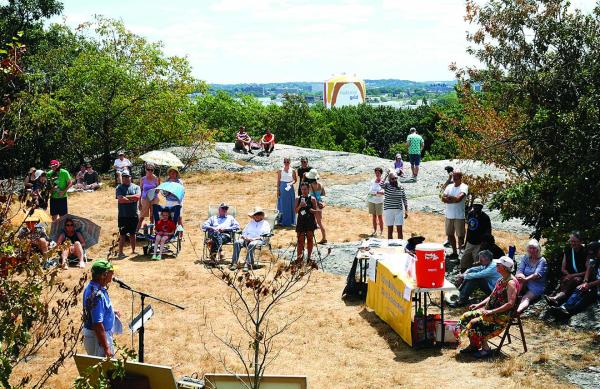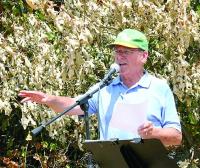August 4, 2022

A group gathered atop Savin Hill last Sunday, July 31 to hear a presentation on the history of the park from Native American historian Thomas Green of the Neponset Massachusett tribe and longtime resident Bill Walczak. The event included a ceremonial blessing of the land, led by Green. Seth Daniel photo

Last Sunday (July 31), dozens gathered atop Savin Hill to hear more about the history of the park and the Neponset band of the Massachusett tribe that lived hereabouts before European settlers arrived in 1630. The event, sponsored by the Dorchester Historical Society and the Columbia-Savin Hill Civic Association, featured remarks by Thomas Green, a Bay State native and descendant of the Massachusett tribe, who also led a blessing ceremony. Bill Walczak, a longtime Savin Hill resident and a Reporter columnist, also spoke. Following are excerpts from what he had to say:
“Savin Hill Park is a marvelous place. Though I have lived next to the park for over 40 years, I still remember the first time I encountered it. The hill was a mess. There were pieces of a burnt cars in the overgrown grass and thorn bushes, along with thousands of shards of glass from a party where beer bottles were smashed on the rocks. But the view from the top of the hill was magnificent. I remember thinking at the time that if this park were in my native New Jersey, it would be a tourist attraction.
“Savin Hill rises about 100 feet above sea level in a location very close to the coast. It is a hill called a drumlin, left by the retreating glaciers about 20,000 years ago. It is made up of a stone that the Puritan settlers called “puddingstone” because it reminded them of their pudding.
“When the Puritans arrived in Dorchester on June 6, 1630, they landed near Savin Hill (which they named “Rock Hill”), at a place called “Mattapannock” by the indigenous Massachusett tribe.
“The Puritans’ concern was the French. The Dorchester settlers knew that the French had been trading with local tribes, so leaders required all to build their homes within a half mile of the meeting house, located at that time where Pleasant Street and Pond Street intersect, in case the French raided the settlement. In 1634, residents built a fort on top of Rock Hill and in 1639, they put “Great Guns,” i.e., cannon, on it to protect themselves.
“Savin Hill was used during the Revolutionary War as the southern point of the Continental Army’s forces when the British controlled Boston and Gen. George Washington’s army surrounded Boston in 1775-76. Soldiers lived in two barracks on Savin Hill, one of which was still in existence in 1906. The hill was also fortified during the War of 1812, and, during the 19th century, militias camped on Savin Hill during summers, which is shown in an 1819 painting that can be seen at the Old State House.
“The Hill has had several name changes. From 1630 to 1730 it was called Rock Hill, and from 1730 to 1830 it was called “Olde Hill.” In 1796, the hill came into the possession of the Worthington Family, whose house on Dorchester Avenue became the rectory of St. William’s Church, unfortunately demolished when the newer St. William’s Church (now the Waymark Seventh Day Adventist Church) was built.
Thomas Green, of the Neponset Massachusett Tribe, offers ceremonial tobacco to residents who wanted to participate in the traditional land blessing of Savin Hill. Seth Daniel photos
“In 1822, Joseph Tuttle built the Tuttle House hotel where Cristo Rey School is now located. He thought that Olde Hill didn’t sound enticing enough for bringing in customers, and renamed it Savin Hill, after the Eastern Red Cedar tree, which predominated on the mount. The Eastern Red Cedar was commonly called Savin Tree at the time. In stories told about the hill in the 19th century, the hill was used for hiking and picnicking. Edward Everett wrote of going up to the hill as a boy to hike and play games.
“In 1870, Dorchester was annexed to Boston, along with Roxbury, and the Boston Parks Commission looked for places to create parks in these two new sections. Savin Hill was a prime site, but the Worthington Family said no to the offer from the city to sell it their land for a park. Sometime before 1884, the family divided the land up for house lots.
“But James Stark, who lived in the brick house at the corner of Savin Hill Avenue and Grampian Way, was undeterred. In 1883, Stark, who was instrumental in starting the Dorchester Historical Society, began campaigning to get the city to purchase the land for a park. Mayor Josiah Quincy VI, who had purchased Savin Hill Beach for the city, tried to buy the Hill, but before that happened, his term ran out in 1900. His successor, Mayor Hart, said that if re-elected after his 1900-1902 term, he’d buy the land, but he wasn’t re-elected. Then followed Mayor Collins, 1902-05, who said he’d buy it for a suitable price.
“The Dorchester Historical Society negotiated with the Worthington Family, who said that they’d sell the land for the back taxes owed by the family, which was $30,000. There was an agreement with the city, but no purchase took place. The next two mayors, John “Honey Fitz” Fitzgerald (1906-08) and George Hibbard (1908-10), were pivotal. Fitzgerald agreed to get the park funded by the city after a ratification meeting drew 500 “prominent persons of the district” to a meeting at the Savin Hill Yacht Club. Hibbard made the actual purchase.
“It took 25 years for James Stark and the Dorchester Historical Society to create Savin Hill Park, a tribute to the power of persistence and community organizing. Reclamation of the park from the vandalism and neglect that I first encountered 46 years ago has also been the result of decades of neighborhood activism and advocacy.
“Stewardship and maintenance of this precious public green space is the responsibility of the Boston Parks Department. If you see something amiss, dial 311.”



